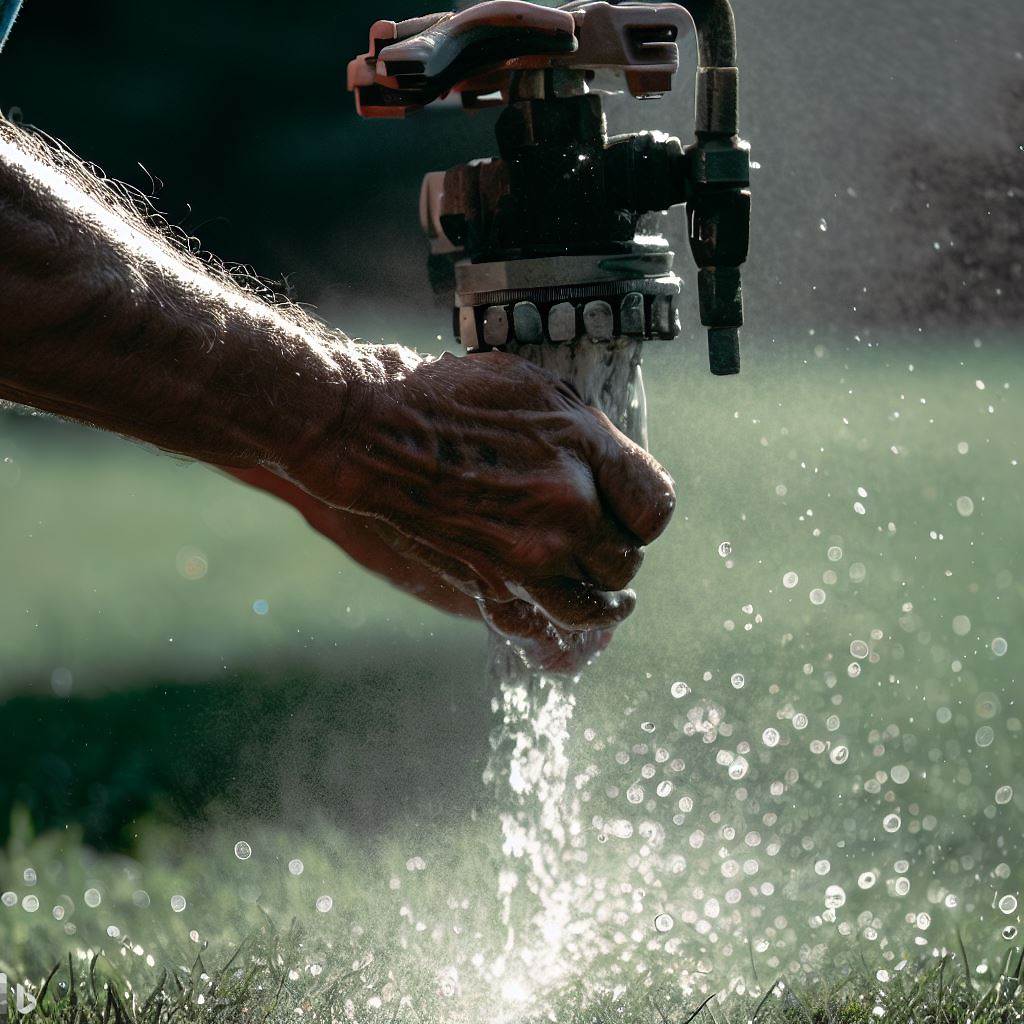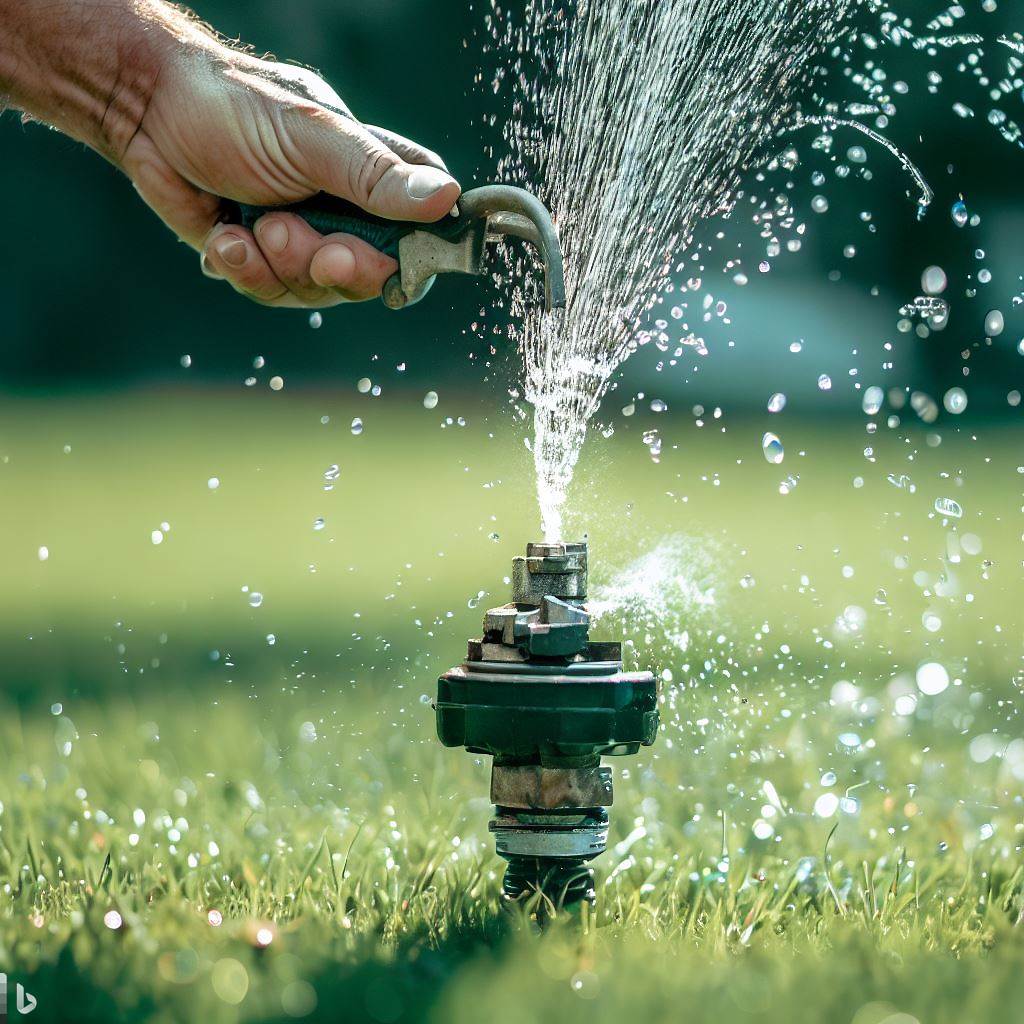Step into the realm of sprinklers, where tiny water droplets perform their dance, transforming lawns into vibrant displays of life and color. Yet, even in this enchanting world, the issue of clogged sprinkler heads can arise. If you’ve faced the frustration of a lackluster trickle instead of a vibrant shower, our guide to ‘unclogging sprinkler heads’ is here to help you restore the magic.
Throughout our journey together in this blog post, we’ll venture deep into the belly of the beast – that’s right – straight down into those perplexing holes where dirt and debris love to hide. Together we’ll unmask these culprits and gently coax them out using tools you already have at home!
So strap on those garden gloves folks because it’s time for Operation Sprinkler Rescue! Just imagine how satisfying it’ll feel when you see that powerful spray arc across your lawn again as if saying “Thank You”. Stay tuned for an exciting drip-free adventure waiting just below…

Identifying Clogged Sprinkler Heads
Clogged sprinkler heads can be a frustrating problem for homeowners who want to maintain an immaculate lawn. Before we dive into the nitty-gritty of unclogging sprinkler heads – pesky culprits – it’s essential to understand how to identify them.
One telltale sign of a clogged sprinkler head is uneven water distribution. If you notice dry patches or areas that receive more water than others, there’s a good chance you have a clog on your hands.
Another indicator is reduced water pressure coming from one or more sprinklers in your system.
Regular Inspection and Maintenance of Irrigation System
To prevent clogs from wreaking havoc on your irrigation system, regular inspection and maintenance are crucial.
Make it a habit to inspect your sprinklers at least once every few months, especially during the watering season.
During this inspection, pay close attention to any debris or dirt buildup around the nozzles and pop-up mechanism. Remove any obstructions by gently brushing away loose materials using a soft-bristle brush or compressed air if needed.
It’s also important to check for leaks in the system that could lead to water wastage or cause further issues down the line. Repair any damages promptly before they worsen.
Methods to Uncover Blocked Sprinkler Head
Now that you know how critical regular maintenance is let’s move on to methods that will help uncover if you indeed have blocked sprinkler heads within your irrigation system:
1. Visual Inspection
Walk through your yard while running each zone individually and observe each sprinkler head closely. Look out for signs of blockage such as misaligned spray patterns, restricted flow rate, or even complete lack of operation.
– Misaligned spray patterns can indicate a blockage, which often causes the water stream to deviate from its intended path or result in uneven coverage.
– Restricted flow rate is noticeable when the sprinkler head does not allow an adequate amount of water to pass through. This may be due to debris lodged within.
2. Pressure Testing
Connect a pressure gauge to your outdoor faucet and turn it on slowly until you reach your system’s operating pressure (usually between 30-50 psi). Then, run each zone individually and monitor any significant drops or irregular fluctuations in the pressure readings.
A sudden drop in pressure could signal a clogged sprinkler head along that specific zone.
3. Catch Cups
Place catch cups – small containers such as plastic cups or tuna cans – at different distances within one zone while running it for a set period of time (10-15 minutes should suffice).
Measure the amount of water collected per cup and compare them afterward.
If there are drastic variations in the quantities gathered, it suggests that certain sprinklers may have clogs affecting their performance.
Step-by-Step Guide on How to Unclog Sprinkler Heads
Now that we’ve identified potential clogs let’s dive into how you can unclog those stubborn sprinkler heads:
1. Turn off Water Supply
Before attempting any repairs, ensure you shut off the water supply to prevent accidental flooding or damaging other parts of your irrigation system.
2. Dig Out Sprinkler Head
Using a shovel or trowel, carefully dig around the affected sprinkler head until you expose enough piping for easy access. Be cautious not to damage any pipes during this process.
3. Unscrew Sprinkler Head
With adjustable pliers or wrenches suitable for PVC fittings (if applicable), gently unscrew and remove the clogged sprinkler head from its riser pipe connection beneath ground level.
4. Clean Sprinkler Head
Rinse the removed sprinkler head using a strong jet of water, ensuring all dirt, debris, and clogs are thoroughly cleared from the nozzle and filter screen (if present). Pay close attention to any stubborn residues that may require additional cleaning measures.
5. Check Riser Pipe for Blockages
While you have the sprinkler head removed, inspect the riser pipe for any blockages or obstructions. Use a long flexible wire or a plumbing snake to dislodge any debris stuck within.
6. Reinstall Sprinkler Head
Once your sprinkle head is clean and clear of clogs, screw it back onto the riser pipe firmly but avoid overtightening to prevent damage.
7. Backfill Soil
Carefully replace the soil around the sprinkler head and lightly press it down until firm but not compacted.
8. Test System Operation
Turn on your irrigation system’s water supply again and run each zone individually to check if the previously blocked sprinklers now function correctly with even coverage.
Common Tools Needed for Unclogging
When it comes to unclogging sprinkler heads effectively, you’ll need some common tools readily available at most hardware stores:
1. Adjustable pliers or wrenches suitable for PVC fittings
2. Shovel or trowel
3. Soft-bristle brush
4. Compressed air canister (optional)
5. Pressure gauge
Prevention Measures For Future Clogs In Your Sprinklers
Now that you’ve successfully cleaned your sprinkler heads let’s discuss prevention measures to keep them flowing smoothly in the future:
1. Clear Surrounding Area: Regularly remove leaves, twigs, grass clippings, and other debris from around your sprinklers’ nozzles to minimize potential blockages.
2. Trim Surrounding Vegetation: Trim back plants or shrubs near the sprinkler heads to avoid interference with the water spray pattern and prevent debris buildup.
3. Install Filter Screens: If your sprinkler heads don’t have filter screens, consider installing them. These screens can help trap smaller particles before they enter and clog the system.
How Often Should You Clean Sprinkler Heads?
The frequency at which you should clean your sprinkler heads depends on several factors such as location, climate, and landscaping practices.
As a general rule of thumb, plan on inspecting and cleaning your sprinklers at least twice a year – once before the watering season begins in spring and again before winterizing your system for colder months.
However, if you notice signs of reduced performance or uneven water distribution during regular operation, it’s necessary to address those issues promptly by cleaning affected sprinklers anytime throughout the year.
Troubleshooting Other Common Issues with Garden Sprinklers
While clogged sprinkler heads are a common problem faced by homeowners, other issues may also arise within your garden irrigation system. Here are some troubleshooting tips for additional problems:
1. Uneven Water Distribution: Adjust each individual nozzle’s range or rotation settings to ensure even coverage across your lawn.
2. Leaks or Water Wastage: Inspect all connections throughout the system for leaks or loose fittings. Tighten any loose connections using appropriate tools or replace damaged components as needed.
3. Stuck Valves: If you experience difficulties starting or stopping certain zones properly when running the system manually from your controller unit, it might be due to stuck valves. Locate these valves (usually near manifolds) and attempt to free them through gentle manipulation or replacement if necessary.
4. Controller Unit Malfunctions: Check batteries if applicable; replace old ones with new ones if needed. Consult the manufacturer’s manual thoroughly if initial errors persist.

Conclusion
Remember that proper maintenance is key to keeping your sprinkler system in excellent working condition. By following the steps outlined above and staying proactive with regular inspections, you can ensure a beautiful and healthy lawn all year round.
FAQs On Unclogging Sprinkler Heads
Q: How often should I clean my sprinkler heads?
A: It is recommended to clean your sprinkler heads regularly, at least once every few months. This will help prevent any clogging issues and ensure a proper water flow.
Q: What are the common issues with sprinkler heads?
A: Some common sprinkler head issues include clogs caused by debris, leaks, mist or spray instead of a steady stream, and malfunctioning heads that don’t pop up or spray correctly.
Q: How do I unclog a sprinkler head?
A: To unclog a sprinkler head, first turn off the water supply. Then, use a cloth or your hand to wipe the sprinkler head and remove any debris that may be causing the clog. Once cleaned, turn the water back on and check if the water flow is restored.
Q: How can I prevent clogs in my sprinkler heads?
A: One way to prevent clogs is to lift and straighten the head if it becomes tilted or settled. You should also remove the sprinkler heads often to check for any debris or mineral deposits that may have accumulated inside.
Q: Can I use a household rust remover to clean my sprinkler heads?
A: While a common household rust remover might work for some sprinkler head issues, it is not recommended as it may cause damage to the head or affect the distribution of water. It’s best to use a solution specifically designed for cleaning sprinkler heads.
Q: Should I replace the sprinkler head if it is not working correctly?
A: Before replacing the sprinkler head, try cleaning it first. In many cases, a simple cleaning can fix the issue. If cleaning doesn’t work, then you may need to replace the head.
Q: How do I remove the sprinkler head for cleaning or replacement?
A: To remove the sprinkler head, start by turning off the water supply. Then, use a wrench or your hand to unscrew the head counterclockwise. Once removed, you can clean or replace the head as needed.
Q: What should I do if my sprinkler head is leaking?
A: A leaking sprinkler head may indicate a problem with the seal or a damaged head. Start by checking if the head is screwed on tightly. If it is, and the leak persists, you may need to replace the seal or the entire head.
Q: How can I prevent my sprinkler heads from getting clogged with mud or debris?
A: One way to prevent clogs caused by mud or debris is to adjust the sprinkler head level with the ground. This will minimize the chances of dirt or rocks getting inside and causing clogs.
Q: Can I use a wire or paper clip to unclog my sprinkler head?
A: Using a paper clip or a piece of wire to unclog a sprinkler head is not recommended. It may damage the head or worsen the clog. It’s best to use proper cleaning tools or consult a professional.